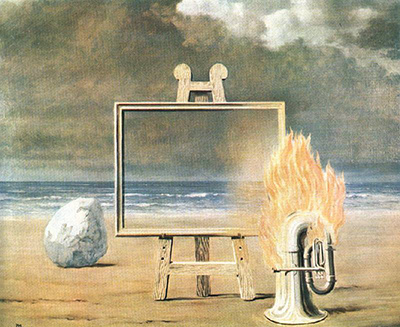There are two versions of 'The Fair Captive' by Rene Magritte, the prolific Belgian surrealist painter. The first, painted in 1931, contains an easel which you can apparently see through to the landscape background.
The second, painted in 1947, also uses what appears to be a transparent easel but, this time, it is set in a beach with a burning tuba in front. A reflection of the flames emanating from the tuba, however, can be seen in that easel.
Numerous works of Magritte use a painting within a painting and the first 'The Fair Captive' painting was followed by a series called 'The Human Condition' which also makes use of this idea. Magritte may have come across this in A. Cassagne's Traite pratique de perspective (1873) which students at the Academie Royal des Beaux Arts studied at the time Magritte was there. He may also have seen De Chiricho's work, the 'Great Metaphysical Interior'.
Magritte was, in 'The Fair Captive' as in other works of his, fascinated by the paradox between a painted image and what that image conceals. In these paintings the easel is apparently transparent but, somehow, it is definitely a painting. This means that, for example, the houses in the 1931 painting are both inside the room and outside in the landscape at the same time.
In the 1947 version the easel is made real by the reflection of the flames shown coming out of the tuba in front of the easel. Again the sea is both in the position of the painting and at a distance behind the painting. As in the later 'The Human Condition' series the easel, seeming like glass, reveals what is expected to be concealed by it.
This was part of the interest Magritte had in what was concealed and what revealed in life and art. Just to confuse things the stand and edge of the easel unmistakenly conceals whatever is behind it. The title 'The Fair Captive', like many of Magritte's titles, is problematic as, like many of his titles, it seems to be parallel with the painting rather than directly related to it perhaps making additional use of the literal meaning of surrealism - another reality.




